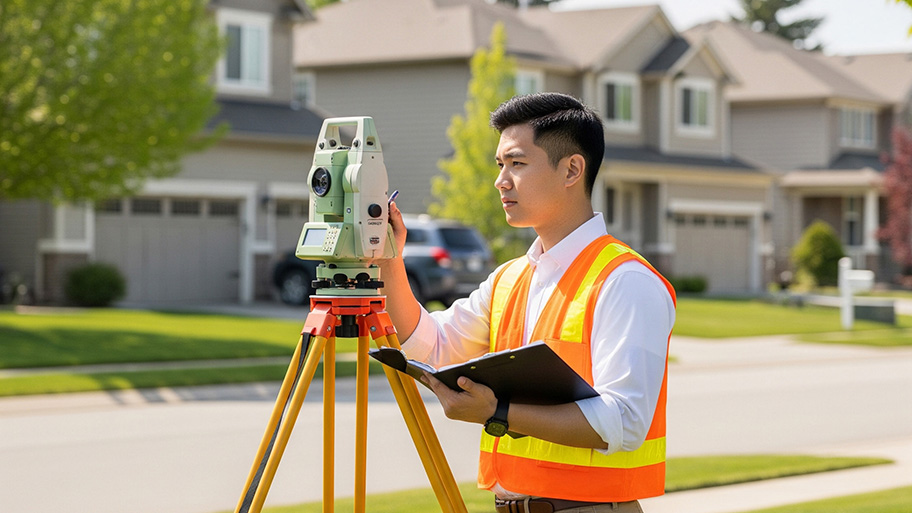
Just bought a plot of land and need to get it build-ready? Learn how much it costs to clear land to gauge your initial budget before you break ground.
Mark your territory with these tips


You don’t want to overstep your bounds, but you definitely want to make sure your neighbors don’t either. However, it’s not always clear how to find your property lines. To find your property lines for a fence, check your property deed, call a land surveyor, or look for property markers. Doing so can help you avoid possible disputes or even legal troubles. So, let’s walk through several ways to find your property lines, so you can rest easy knowing exactly where you—and your property—stand.
Property lines are the boundaries that legally define a piece of property. As a homeowner, you can indicate your property lines by physical objects (streets, sidewalks, fences, etc.). In some cases, especially if you and your neighbor have large, unfenced yards, there may be nothing separating your property.
Oftentimes, fences sit directly on a property line, which can cause uncertainty about who owns it—and therefore who’s responsible for maintenance and repairs. In these instances, we recommend talking to neighbors and clarifying who is ultimately responsible for the fence.
Even invisible property lines matter a lot. You can get yourself into legal trouble with a neighbor for building on their property, which can be both a costly and frustrating experience. This project isn’t the most costly home improvement, but, on average, a fence installation costs up to $4,800—and that’s not something you’ll want to repeat if your original fence is on your neighbor’s property. When considering building a fence in the winter or spring or even adding shrubs along your property line, you want to be sure you know where yours lies.
You can read your property survey to find your ideal fence lines, and there may be an existing land survey of your property already available. A survey may have been conducted upon the purchase of your home. Lenders or insurance companies often require a survey as part of the transaction, so review your home closing paperwork to see if a property survey is included. You could also reach out to the previous owner of your home if you have their contact information to see if they still have a copy of the latest survey.
Your local county record or assessor’s office should have maps that show where your property line lies. In some cases, this information may be available online, or you may have to go into an office building.
In either case, there is usually a small fee (under $25) to access this information.

When you bought your house, a homeowner’s deed was transferred to give you legal rights to your home and surrounding land. On this deed, you can usually find a physical description of your property line (sometimes including measurements). Using a tape measure (or the physical objects the deed references) you can find your property line yourself.
If you financed your home and still make mortgage payments, the bank or lender you borrowed from will hold your homeowner’s deed, which you can gain access to if you call them for the information. You may also be able to acquire the deed info from your local county recorder’s office.
Keep in mind that for older homes, the deed may describe items no longer on the property (e.g., trees or shrubs). If this is the case, the information may not be as helpful.

When new homes are built, contractors often use survey property pins to outline the property lines. This enables them to build in the proper location and avoid building on someone else’s land.
Often, these stakes, which are pieces of iron stuck into the ground, are left behind after construction. Look for them along curbs, by the sidewalk, or along the back of your property to confirm location.
Keep in mind that survey pins can be moved. For example, a gas or utility company might move them when installing a gas line. So using survey pins as a point of reference may be better as a reinforcement method than a primary one.
Your county’s zoning department should also have a physical copy of your property with reference points or measurements that indicate where your property lines lie.
Again, you may have to pay a small fee (under $25) for this information. Look online to see if it can be ordered instead of going to the physical office, which may be in another town.

If the information on your property line isn’t in the deed or available to you at the county office, a local licensed land surveyor can help. Their job is to find and measure where your property line ends, and your neighbor’s begins.
Land surveyors cost between $800 and $5,500, depending on the complexity of the job. Larger properties, or those with more corners to them, will cost more simply due to the time it takes to measure out your property.
Hiring a land surveyor is worth it if you don’t know where your property lines are, but you’d like to build on your property or extend an existing structure.

In certain instances, such as when you live in a remote area, you may still struggle to find your property lines. A lot line agreement (or “adjustment agreement”) is basically an agreement you and your neighbor make to settle where your property line lies.
This legally binding method can help settle a dispute without involving costly lawyers. If you’re friendly with a neighbor, this is definitely a strategy to consider before taking more drastic measures.
Most fence companies will not find your property lines for you—rather, the responsibility lies with the homeowner. The local fence company you hire will install the fence wherever you tell them to, so it is important to know exactly where your property lines are before starting the project. You can either stake out the property lines yourself using a tape measure, compass, and existing survey information or hire a land surveyor in your area to conduct a property lines survey.
From average costs to expert advice, get all the answers you need to get your job done.

Just bought a plot of land and need to get it build-ready? Learn how much it costs to clear land to gauge your initial budget before you break ground.

Discover site preparation cost estimates, including average prices, cost factors, and tips to help homeowners budget for their next project.

A land survey can determine your property’s borders and settle property disputes. Learn how much a land survey costs and what can affect the price.

Not sure what kind of property survey you need? Learn about the differences between a land survey vs. a boundary survey to get started.

Boundary surveys and topographic surveys provide important information about a property. Learn the differences between boundary and topographic surveys.

Real estate transactions often require a survey, but who pays for it? Learn who pays for a land survey in most cases and some exceptions to the norm.